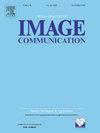DA-Net: Deep attention network for biomedical image segmentation
IF 2.7
3区 工程技术
Q2 ENGINEERING, ELECTRICAL & ELECTRONIC
引用次数: 0
Abstract
Deep learning-based image segmentation techniques are of great significance to biomedical image analysis and clinical disease diagnosis, among which U-Net is one of the classic biomedical image segmentation algorithms and is widely used in the field of biomedicine. In this paper, we propose an improved triplet attention module and embed it into the U-Net framework to form a novel deep attention network, called DA-Net, for biomedical image segmentation. Specifically, an additional layer is stacked into the original U-Net, resulting in a six-layer U-shaped network. Then, the double convolution module of the U-Net is replaced with a composite block which consists of the improved triplet attention module and the residual concatenate block, to obtain abundant valuable features effectively. We redesign the network structure to increase its width and depth and train our model with the pixel position aware loss, realizing the synchronous increase of the mean IoU value and average Dice index. Extensive experiments have been carried out on two publicly available biomedical datasets, including the 2018 Data Science Bowl (DSB) and the international skin imaging collaboration (ISIC) 2018 Challenge, and a self-built fetal cerebellar ultrasound dataset from Affiliated Hospital of Jiangsu University, named JSUAH![]() Cerebellum. The mIoU and mDice of DA-Net can reach 87.45 % and 92.98 % on the JSUAH
Cerebellum. The mIoU and mDice of DA-Net can reach 87.45 % and 92.98 % on the JSUAH![]() Cerebellum, 87.36 % and 91.37 % on the 2018 Data Science Bowl, and 86.75 % and 91.34 % on the ISIC-2018 Challenge, respectively. Experimental results demonstrate that our DA-Net achieves promising performance in terms of segmentation robustness and generalization ability.
Cerebellum, 87.36 % and 91.37 % on the 2018 Data Science Bowl, and 86.75 % and 91.34 % on the ISIC-2018 Challenge, respectively. Experimental results demonstrate that our DA-Net achieves promising performance in terms of segmentation robustness and generalization ability.
DA-Net:用于生物医学图像分割的深度关注网络
基于深度学习的图像分割技术对生物医学图像分析和临床疾病诊断具有重要意义,其中U-Net是经典的生物医学图像分割算法之一,在生物医学领域得到了广泛应用。本文提出了一种改进的三重注意模块,并将其嵌入到U-Net框架中,形成一种新的深度注意网络,称为DA-Net,用于生物医学图像分割。具体来说,就是在原有的U-Net中增加一层,形成一个六层的u型网络。然后,将U-Net的双卷积模块替换为由改进的三重关注模块和残差连接块组成的复合块,有效地获得了丰富的有价值的特征。我们重新设计网络结构,增加其宽度和深度,并利用像素位置感知损失来训练我们的模型,实现了平均IoU值和平均Dice指数的同步增加。在2018年数据科学碗(DSB)和国际皮肤成像协作(ISIC) 2018挑战赛两个公开的生物医学数据集,以及江苏大学附属医院自建的胎儿小脑超声数据集JSUAHCerebellum上进行了大量实验。DA-Net的mIoU和mdevice在JSUAHCerebellum上分别达到87.45%和92.98%,在2018年数据科学碗上分别达到87.36%和91.37%,在ISIC-2018挑战赛上分别达到86.75%和91.34%。实验结果表明,我们的DA-Net在分割鲁棒性和泛化能力方面取得了很好的效果。
本文章由计算机程序翻译,如有差异,请以英文原文为准。
求助全文
约1分钟内获得全文
求助全文
来源期刊

Signal Processing-Image Communication
工程技术-工程:电子与电气
CiteScore
8.40
自引率
2.90%
发文量
138
审稿时长
5.2 months
期刊介绍:
Signal Processing: Image Communication is an international journal for the development of the theory and practice of image communication. Its primary objectives are the following:
To present a forum for the advancement of theory and practice of image communication.
To stimulate cross-fertilization between areas similar in nature which have traditionally been separated, for example, various aspects of visual communications and information systems.
To contribute to a rapid information exchange between the industrial and academic environments.
The editorial policy and the technical content of the journal are the responsibility of the Editor-in-Chief, the Area Editors and the Advisory Editors. The Journal is self-supporting from subscription income and contains a minimum amount of advertisements. Advertisements are subject to the prior approval of the Editor-in-Chief. The journal welcomes contributions from every country in the world.
Signal Processing: Image Communication publishes articles relating to aspects of the design, implementation and use of image communication systems. The journal features original research work, tutorial and review articles, and accounts of practical developments.
Subjects of interest include image/video coding, 3D video representations and compression, 3D graphics and animation compression, HDTV and 3DTV systems, video adaptation, video over IP, peer-to-peer video networking, interactive visual communication, multi-user video conferencing, wireless video broadcasting and communication, visual surveillance, 2D and 3D image/video quality measures, pre/post processing, video restoration and super-resolution, multi-camera video analysis, motion analysis, content-based image/video indexing and retrieval, face and gesture processing, video synthesis, 2D and 3D image/video acquisition and display technologies, architectures for image/video processing and communication.
 求助内容:
求助内容: 应助结果提醒方式:
应助结果提醒方式:


